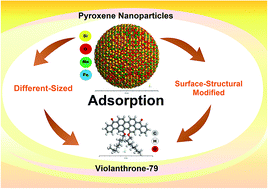Effect of nanosized and surface-structural-modified nano-pyroxene on adsorption of violanthrone-79†
Abstract
This study presents new environmentally sound and low-cost yet highly efficient pyroxene (NaFeSi2O6, PY), known as aegirine, nanoparticles. They are applied for the first time for the adsorptive removal of violanthrone-79 (VO-79) which was selected as a model-adsorbing compound to mimic polar heavy hydrocarbons. PY nanoparticles are prepared by a low temperature hydrothermal synthesis route. Controlled particle sizes of PY nanoparticles were synthesized in the range between 1 and 100 nm. Moreover, the surface and structure of the PY nanoparticles were modified by partially replacing some of the original atoms, like Na, Fe or Si, by Ce, Zr, Ni, Ca and H to enhance their adsorption capacity towards VO-79. One nanoparticle size was prepared at different synthesis heat-treating times to investigate the stability of the nano-adsorbent. It has been found that PY nanoparticles with particle sizes in the range between 30 and 60 nm have the highest adsorption capacity and affinity towards VO-79. The adsorption capacity of the VO-79 over functionalized PY nanoparticles was increased significantly in the order of PY–H > PY–Ca > PY–Ni > PY–Ce > PY–Zr, when compared with unmodified PY nanoparticles. Varying the heat-treating time of synthesis of PY nanoparticles did not affect their size stability and surface properties. Moreover, no significant increase towards VO-79 adsorption uptake was detected. The experimental macroscopic adsorption isotherms fit well to the Sips model, indicating a heterogeneous adsorption system.


 Please wait while we load your content...
Please wait while we load your content...